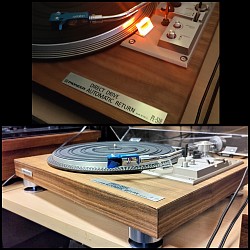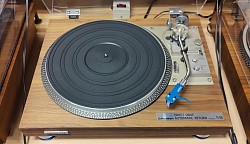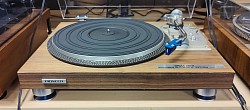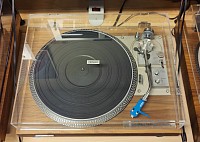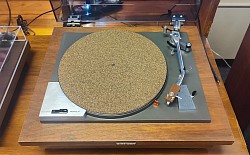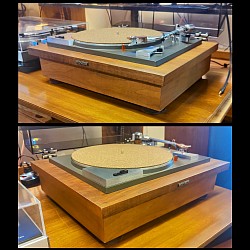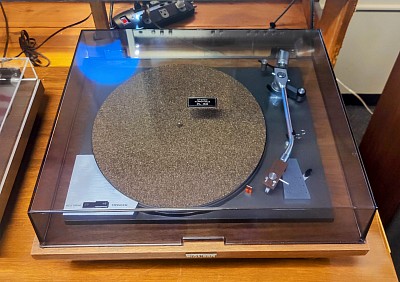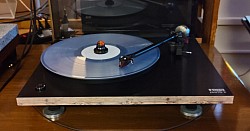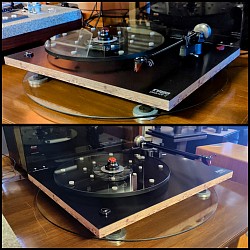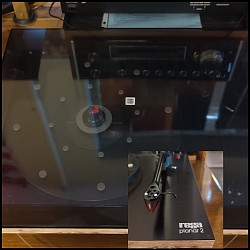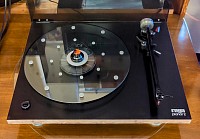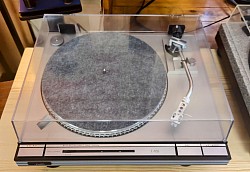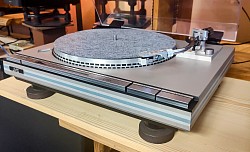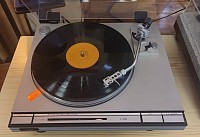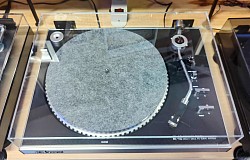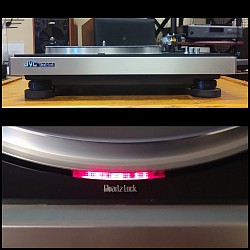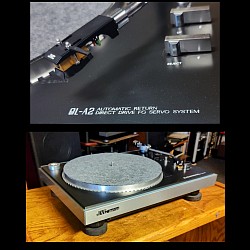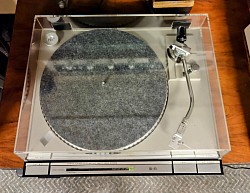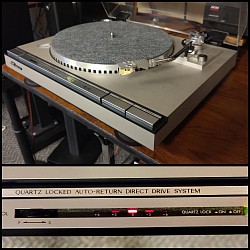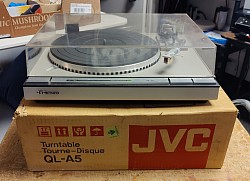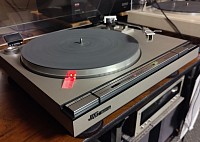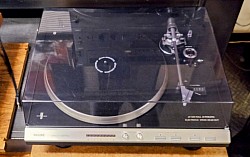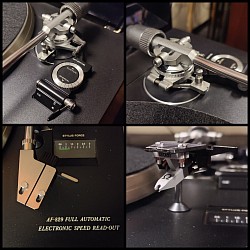Page 2 Stereo Turntables (NO shipping)
Pioneer PL-518
(1978) $750 (custom plinth + extras)
In absolutely pristine cosmetic condition and fully operational, this Pioneer PL-518 is a mid-to-high level, 2-speed, direct-drive, semi-automatic turntable fitted with a static balance type, S-shaped tonearm.
The custom, hand-built tigerwood veneer plinth is elegant and unique making this a one-of-a-kind Pioneer PL-518. The tonearm is equipped with a brand new Ortofon Blue cartridge and stylus mounted on a beautiful blue aluminum Ortofon headshell. This excellent Pioneer turntable also comes with a brand new custom acrylic dust cover. Finally, this beauty has four fully adjustable solid steel feet with rubber cushions.
The exterior cosmetic design is quite elegant in its own right. The unusual, lightly textured, beige finish is complimented with the control panel's brushed chrome design. At about 21 lbs, the PL-518 is a very solid, well built turntable.
Even though the PL-518 is a semi-auto unit, it was not designed with a reject button, it functions more like a manual, single-play turntable, the kind traditionally preferred by audiophiles and professionals alike, but with two welcome conveniences:
One is the Quick-Start function.
The other is the Auto-Return function, which works like this: when the stylus enters the lead-out groove of your record, a special Pioneer-developed device detects the increased lateral speed of the tone arm and triggers the auto-return mechanism. This lifts the tone arm gently, returns it to its rest, and shuts off all power to the turntable. The mechanism is one that Pioneer had tested successfully for over 100,000 continuous operations, and one guaranteed to perform with minimum noise and maximum reliability.
The PL-518's platter does not begin to rotate until you lift the tone arm and move it toward the outer edge of the platter. This convenience is appreciated all the more when you use it in combination with the oil-damped cueing lever which lets you lower the stylus to the record surface (at the point of your choice) without risk of dropping the arm or nicking the record.
All controls on the Pioneer PL-518 are grouped on the right hand side of the platter to make handling easier still. In addition to the adjustment controls for the tone arm there is the cue lever, speed select button and the fine pitch control. Also on the right is the built-in strobe with an attractively illuminated light/calibration arrangement so that you may keep a visual check on the platter's accurate speed.
Pioneer had developed a 16-pole, 24-slot DC servomotor for the PL-518, one that provides exactly the same high signal-to-noise ratio and low wow/flutter as that used in the more expensive PL-520 model. This motor's magnetic circuit is twice as strong as conventional direct-drive types, a fact which contributes greatly to its improved resistance to torque ripple caused by uneven magnetic force.
Its switching frequency is also doubled, to 13.3Hz. Together these mean improved load characteristics, more accurate platter speeds at all times and, ultimately, better tonal quality results from your records.
You will find that few if any turntables that were originally available in the same price range offered such outstanding performance specifications: the signal-to-noise ratio achieved by the super-silent DC servo direct-drive motor is a high 73dB or less, while wow/flutter is an excellent 0.03% or less, and will stay that way for a good many more years.
Essential specs:
Type: direct drive
Motor: 16-pole, 24-slot, DC servo motor
Speeds: 33 and 45rpm
Speed control range: +-2%
Wow and flutter: 0.03%
Rumble: 73dB
Dimensions: 17.5"W x 6.2"H x 14.4"D
Weight: 21 lbs
+++++++++++++++++++++++++++++++++++++++++
+++++++++++++++++++++++++++++++++++++++++
Pioneer PL-50
(Early 70's) $400
In stunning cosmetic condition and fully operational, we've managed to obtain another of these stunning, early 70's Pioneer PL-50 turntables. In our humble opinion, it's definitely one of the best looking designs to come out of Japan during the beginning of the "Golden Age of HiFi". The owner's manual is included.
(NOTE: Pioneer's model PL-50 had two different years of production. In the early 70's this one described here was the first incarnation of the PL-50 model. Later on, in the late 70's & early 80's, an entirely different PL-50 was released by Pioneer. Other than bearing the same model number, they were entirely different.)
This classic vintage turntable was painstakingly serviced and restored. That includes: a brand new CORRECT 35.1" belt, all pivots, joints and internal contact points lubed and fresh silicone oil applied into the motor bearings. Fortunately, even the oil tubes and wicks leading to the bearings are intact which allows the oil to do its job. The wood has been lightly sanded and refinished. The original, lightly tinted dust cover has been hand-polished.
The PL-50 is a semi-automatic turntable featuring tonearm auto lift, return and shut off at the end of the record. The automatic return and automatic cut are carried out quite simply by moving the single function lever.
The aftermarket timberwood headshell comes with a brand new Ortofon Omega cartridge and stylus. Besides the counterbalance and anti-skate, there is an additional lateral balancing weight attached to the rear of the arm.
The beautiful timberwood base design successfully achieved a high anti-vibration structure along with its massive look. This kind of engineering craftsmanship came from an era when Pioneer's designers insisted on creating a massive real timberwood base to surround and cradle the controls, motor and platter assembly. As the years went by, competition was so fierce that designs featuring real wood were becoming scarce. In order to keep the cost down, some manufacturers began to use less expensive vinyl wraps. Essentially, there's nothing better than real vintage wood on classic vintage models from the early 70's.
When describing the Pioneer PL-50 it's interesting to note that they also built the entire unit around a "floating" suspension that featured a three point spring-on-motor, adjustable VTA on the tone arm and a high rigidity plinth. Pioneer had developed a 4-pole synchronous motor that's so reliable that even some 50 years later, the speed is still very accurate for both 33.3 and 45 RPM. Interestingly, the auto-up-stop mechanism has no electronics involved; it's a purely ingenious mechanical design using a spring activated "catch and release" system. Aside from a switch activated pilot light (that doubles as an overhang index marker), there are no other circuits to worry about. This is a fairly heavy turntable at about 22 lbs and larger than most with dimensions at about 7.75"H x 19.5"W x 16.75"D.
+++++++++++++++++++++++++++++++++++++++++
+++++++++++++++++++++++++++++++++++++++++
Rega Planar 2
('75-'83) $600
Obtained locally from the original owner, this beautiful Rega Planar 2 is in pristine cosmetic and operating condition.
The presence of the spectacular, completely redesigned Rega RB220 tonearm on the Planar 2 was a major draw when first released. The arm is even better with the included brand new Ortofon Red cartridge & stylus.
Drive is via a compliantly mounted AC Synchronous motor with simple phase shift power supply, through an O-ring type belt (the belt is relatively new).
The top platter is a stunning and highly precise *float glass platter. Instead of a mat that would cover the beautiful glass, the record placed on the platter will sit on unique and tiny flexi-foam pads. These unique pads will support the record for either standard 12" LP, 10" EP or 7" 45's. The glass platter sits on a plastic sub platter. The piano-black gloss plinth features faux walnut on the front and sides. The dark tinted acrylic dust cover and original hinges are perfect.
*NOTE: Float glass is a sheet of glass made by floating molten glass on a bed of molten tin due to its low melting point. This method gives the sheet uniform thickness and a very flat surface.
The Rega Planar 2 back story:
In 1976, three years after Rega’s creation, the Planar 2 launched as one of the brand's very first turntables. Its S-shaped tonearm was then replaced in 1984 with Rega’s RB250, and at the turn of the century a brand new version of the deck (fittingly named the P2 2000) took its place in Rega’s catalog until 2005. And the beat goes on...
About Rega...
Rega was founded in 1973. The company's name was formed from the initials of its two founders (RElph & GAndy). Rega are widely known for their turntables – most notably the iconic Rega Planar 3 cartridges and tonearms, and have produced award-winning amplification and speakers for many years. In addition to manufacturing products under their own brand name, they have also served as an OEM of turntables and tonearms for other companies such as NAD & Rotel.
Rega Research is imported and distributed in the US by The Sound Organisation, based in Arlington Texas.
++++++++++++++++++++++++++++++++++++++++++++++
++++++++++++++++++++++++++++++++++++++++++++++
JVC L-A55
('79-'83) $300
In excellent cosmetic condition and fully operational, this late 70's / early 80's JVC L-A55 turntable was built with solid features for solid performance. It features a coreless direct-drive motor, JVC's proprietary "Independent Suspension" system, an excellent tonearm, strobe and pitch controls.
Its operating ease is the first thing they thought of...no question about it. The L-A55 is a semi-auto, so you don't have to worry about placing the arm on the record; just lightly press a button to gently lower it to begin play. At the end of play, the arm will return and the motor will shut off.
The JVC automatic mechanism of the L-A55 is foolproof. And it is far more accurate and gentle than your fingers ever could be. There's never a reason to lower the tonearm by hand at any time.
All of the light touch operating controls are along the front edge and within easy reach even when the dust cover is closed.
JVC used a low-wow coreless DC direct-drive motor in the L-A55 for the sake of speed accuracy. Built entirely by JVC in their own plant, the flawless motor exhibits very low wow and flutter resulting in music that's reproduced pitch perfect.
Tonearm resonance, when excited by warps or eccentricities, even slightly, adds coloration to music, giving a fuzzy edge to it. The balanced "S" shaped tonearm is desensitized to resonance and it also has the original JVC aluminum headshell. Also included is a new Audio Technica AT-3600L cartridge and new ATN-3600 stylus.
The L-A55 has a pitch control that lets you adjust speed up to 3 percent faster or slower than standard. It's a must have feature if you're a musician, amateur or otherwise, for it lets you precisely match the pitch of a record to any musical instrument. Of course, you can quickly return to the right pitch whenever you want thanks to a built-in strobe with neon light.
About JVC (Victor) of Japan...
JVC was established in Yokohama, Japan in 1927 as the Japanese subsidiary of the U.S. firm, Victor Talking Machine Company. They pressed the very first record ever...in Japan in 1930. One of the more interesting facts about JVC was that they built all their products in-house. Many other famous Japanese electronic companies farmed out a lot of design and manufacturing to subcontractors. That alone doesn't mean anything is necessarily wrong with having others build your gear but to have control of the entire process in house was quite unusual. Plus it saved a lot of money...allowing JVC to provide high quality gear at a lower price than some of the competition.
Their unusual approach to design (for vintage stereo gear) included the extensive use of multi-band graphic equalizers instead of simple bass/mid/treble controls. The quality of their vintage turntables and electronic gear is mostly first rate and has emerged from being "under the radar" of collectors looking for excellent value.
JVC QL-A2
('78-'80) $300
In excellent cosmetic and working condition, this JVC QL-A2 turntable was originally designed to compete in the very crowded market of "mid-fi" units in the late 70's. The QL-A2 is a quartz-locked, direct-drive, semi automatic turntable that has automatic return, reject and auto-shutoff.
JVC's super dependable quartz-lock Super-Servo frequency generator combined with the "no cogging" corless, direct-drive DC servo-motor are easily the table's best qualities with yields of only -73dB rumble, 0.025% WRMS wow & flutter and a signal to noise ratio of 72dB. The basic circuit configuration of the QL-A2 is the same one used in their higher end QL-A4 turnable.
Unique to the QL-A2 (and QL-A4) was the "one row" strobe so you can visually confirm speed accuracy. Since the frequency is changed with the speed, only one row of calibration dots is necessary.
The S-shaped tonearm features angular contact bearing with oil-damped cueing. The original headshell comes mounted with a high quality Audio Technica AT-15S cartridge and stylus.
The original factory feet have added 1/2" foam pads to provide vibration isolation. The satin charcoal plinth with the silver accents and the brand new, custom acrylic dust cover really does look stylish and cool! This is a really good looking, extremely reliable turntable.
JVC QL-A5
(1978) $375 (one owner, perfect w/ extras)
In excellent cosmetic and working condition, this JVC QL-A5 turntable was obtained from the original owner and comes with all the factory manuals, documentation, original box and packing materials.
The QL-A5 was designed to compete in the very crowded market of "mid-fi" units in the late 70's. Not quite top of the line but definitely not entry level either. The QL-A5 is a quartz-lock, direct-drive, semi automatic turntable that has automatic return, reject and auto-shutoff.
JVC's super dependable quartz-lock Super-Servo frequency generator combined with the "no cogging" corless, direct-drive DC servo-motor are easily the table's best qualities. The basic circuit configuration of the QL-A5 is the same one used in their higher end QL-A series of turntables. Unique to the QL-A5 (and QL-A4) was the "one row" strobe so you can visually confirm speed accuracy. Since the frequency is changed with the speed, only one row of calibration dots is necessary.
The S-shaped tonearm features angular contact bearing with oil-damped cueing. The original JVC headshell comes mounted with an excellent Audio Technica ST-800 cartridge and new stylus.
The original factory feet have additional 1/2" thick foam pads to help provide excellent vibration isolation. The satin finish aluminum plinth with the silver accents really does look stylish and cool! This is a really good looking, high quality turntable.
Essential specs:
Drive method: direct drive
Motor: quartz locked DC servomotor
Speeds: 33 and 45rpm
Pitch control: +-6%
Wow and flutter: 0.025% WRMS
Signal to noise ratio: more than 75dB
Tonearm: tracing hold type
Frequency response: 10Hz to 25kHz
Dimensions: 6"H x 17.2"W x 15"D
Weight: 15 lbs
About JVC turntables...
JVC was a great manufacturer of audio gear...especially during the 70's. The name had sadly become cheaper in the recession of the late 80s and never really recovered from it. Originally, the Japan Victor Company was once associated with the RCA Victor Company. They built a name providing competing audio equipment at a lower price point than the more established names.
Their cheap gear was exactly that...cheap.
But...their mid-fi and upper ranges were very good to exceptional. There is also some discussion about the competition between JVC and Denon turntables. Looking at the higher end turntables of the two manufacturers, there could be some merit, but who helped who is the big question.
+++++++++++++++++++++++++++++++++++++++++++
+++++++++++++++++++++++++++++++++++++++++++
Philips AF-829
(1980) $350
In excellent cosmetic condition, fully serviced and fully operational, this Philips AF-829 turntable was the top of the line in 1980 from Philips North America division referred to as "HiFi International".
The linear, low mass tonearm comes with a new Ortofon Omega cartridge and stylus. One of the very best features on this table is the built-in weight scale that accurately lets you know how many grams of weight the stylus is tracking with. The quartz lock display is measured with red LEDs on the front panel and all the controls are pressure touch buttons.
The AF829 turntable is front operated, direct control, and fully automatic. Their direct control was a new system combining the advantages of measuring the actual speed at the turntable and the well-known advantages of belt drive, in combination with the subchassis principle used in earlier Philips turntables.
The major achievement was bringing the specs to the level of direct drive, but without the inherent problems of direct drive which requires extremely fine construction to avoid rumble, suppress microphony, and decrease sensitivity to shocks.
Tech info:
The direct control begins rotating the motor at 33 or 45 RPM, as selected. The belt transfers the rotation to the turntable. The speed of the turntable is continuously sensed by the tacho-generator and converted into a voltage, the output of which is fed into the control unit where this voltage is compared to a reference voltage. The resulting difference voltage is used as a control signal to adjust motor speed. Thus in this system all external influences are compensated, including changes in tracking force, different record weights, use of a dust bug, changes in environmental temperatures and relative humidity, mains voltage, and frequency fluctuations.
Features:
~free-floating sub-chassis
~low torsion tonearm
~tachometer
~speed regulation
~CMOS memories (CMOS, which stands for Complementary Metal Oxide Semiconductor, is utilized for designing integrated circuits. This technology finds applications in microprocessors, static RAM, digital logic circuits, and microcontrollers. The main purpose of CMOS in a turntable is to store important automatic system configuration.)
Specs:
System: Direct Control
Operations: Fully automatic
Speeds: 3.33 and 45 rpm
Wow and Flutter : less than 0,025 (WRMS)
Rumble: less than 73 dB (DIN B)
Tonearm Type: Linear
Tracking Error: less than 0°9' /cm
Dimensions: 18"W x 6.5"H x 14.4"D
About Philips North America...
Gerard Philips introduced Philips & Co. in 1891 in Eindhoven, Holland. Anton Philips, Gerard's brother, joined him to help create a prospering company. By the 1900s, the company became Europe's third largest light-bulb manufacturer. The company began constructing plants abroad by the 1930s, including Philips Electronics North America (known then as North American Philips). Televisions and appliances were added to the company's production lines in the 1950s. Two years later, the company signed an agreement with Matsushita Electronics for technology-licensing operations. Philips began producing the audiocassette, the VCR, and laser disc technology by the 1960s. In 1974, North American Philips purchased Magnavox as well as a small interest in Grundig, a German electronics company, in 1979. GTE Television was purchased by North American Philips in 1981, followed by the purchase of Westinghouse's lighting business in 1983. Due to slow computer sales, the company sold its Magnavox Electronics Systems unit in the 1990s. The company also sold its interests in Whirlpool and Matsushita Electronics, and in 1997, Grundig. In 1996, Philips and Sony announced plans for a joint effort to license digital video disk (DVD) technology.
About Philips High Fidelity International...
Philips goes way back to the late 1800's and has always been a respected name in Europe and the Netherlands. Their early development of loudspeaker technology pushed them into the high end section of audio. A little known fact: They also invented and developed the cassette tape among other things. Before they became well known in America, they were a leading maker of turntables, speakers and higher end electronics all over the rest of the world. When they moved into the North American market in 1974 and purchased Magnavox, they dropped the "High Fidelity International" and became "Philips" and/or "Philips Laboratories".
+++++++++++++++++++++++++++++++++++++++++
+++++++++++++++++++++++++++++++++++++++++
